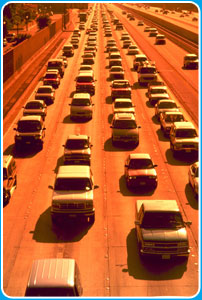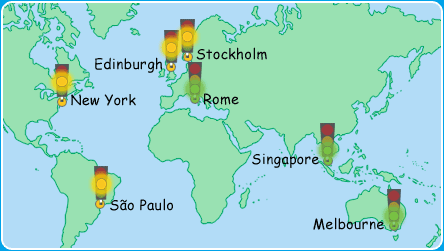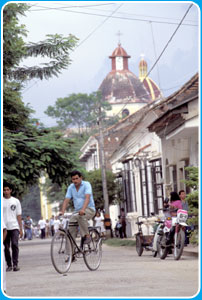| � |
A Gridlocked Future?
| In many cities, exploding levels of traffic are making life unbearable. Traffic jams are getting longer and more frequent, adding to people's fuel bills and polluting the air. Yet the rise in traffic is rarely matched by an improvement in the transport network. The UK's roads are the most congested in Europe - traffic levels are now ten times higher than fifty years ago.
Traffic is by far the biggest culprit of air pollution in cities today. Emissions from vehicles running on diesel can be very high, and leaded petrol is still widely used. Each year, air pollution from traffic claims 400,000 lives a year, mostly in developing countries. |

There are more cars than people in Los Angeles.
� Rex Features |
Worldwide Vehicle numbers (in millions)
| Year |
Cars & Light
Trucks
 |
Heavy Vehicles
 |
Two Wheelers
 |
| 1990��� |
540 |
30 |
110 |
| 2030 |
910 |
60 |
180 |
| 2100 |
1200 |
110 |
250 |
Work out the predicted percentage increase between 1990 and 2030 for each of the three types of traffic. Click here if you need help.
Cities across the world have been watching with interest to see whether London's congestion charge succeeds. Central London's traffic has already dropped by 40% and average speeds within the zone are now at their highest since the 1960s. Meanwhile, over a million more people are using London's improved fleet of buses each day as an alternative. Nevertheless, businesses within the zone now have rising costs from deliveries, and some drivers complain of being charged unfairly.
Visit www.guardian.co.uk/flash/0,5860,526746,00.html to find out how the congestion charge in London works.
Other cities have either taken up a similar scheme of charging motorists or are planning some form of congestion charge in the future. Click on the cities on the map to find out more.

Based on information from Transport for London
| From the map, choose one of the cities that plans to introduce a congestion charge in the future. Imagine you work for a campaign team for the city authority.
- Design an eye-catching and informative full-page advert for the city's newspapers or a web page to convince local residents of the need for a congestion charge.
- Use the website links included on the map and do your own research about the city's traffic situation.
- For more background on the pollution caused by traffic in our cities, visit Global Eye Spring 04.
| Register on www.geographyinthenews.rgs.org to access an in-depth report on congestion charging with follow-up activities. |
� |
 |
|
| City authorities in Colombia's capital city, Bogot� have taken a different approach to traffic snarl-ups. Click on the image to find out more. |

� Jeremy Horner/Panos Pictures |
Visit Global Eye Spring 2004 to find out more about Global Cities today and their future.
Air traffic is also at an all-time high. Go to the next page to find out more.
|
� |







